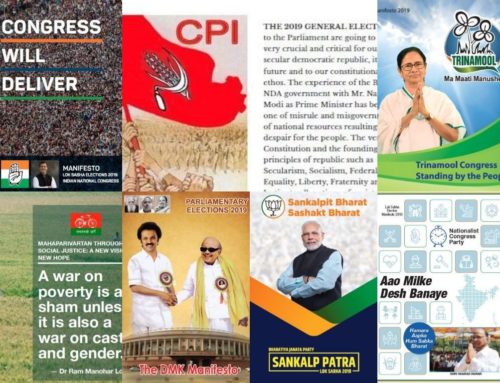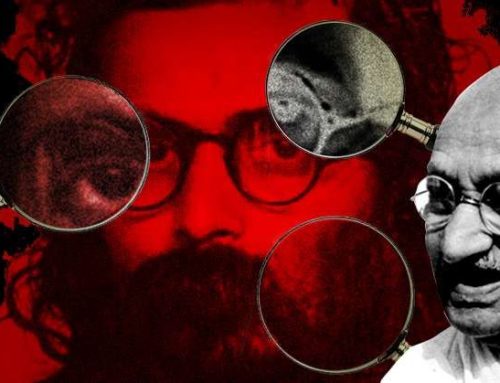GOD, HOLY TEMPLES AND UNHOLY WOMEN
Neha Dabhade
(Secular Perspective March 1-15, 2016)
The news is abuzz with the protests led by women to enter holy shrines – be it the temple of Sabarimala, Shani Shingnapur or Haji Ali. These women have one very fundamental and seemingly simple demand – entry to the shrines. At the famous Sabarimala temple in Kerala, women between the age of 10 to 50 years or of reproductive age are not allowed to enter the temple. Women in this age group have menstruation cycles and thus considered impure. The board of the temple outraged social consciousness of the country by claiming to introduce machines to detect women during their menstruation and deny them entry in the temple. This also led to the popular ‘happy to bleed’ campaign initiated by a young girl against menstrual taboos. More recently, a group of women was forcefully intercepted in their attempt to enter the Shani Shingnapur temple in Ahmednagar of Maharashtra. The reasons cited were that Lord Shani can cast an evil eye on the women, the Lord can affect the health of pregnant women by emitting harmful radiations having adverse effect on the foetus and quite simply, Lord Shani doesn’t like women! Equally incredulous is the reason cited by the Board of the Haji Ali Dargah in Mumbai which stated that women can’t go up to the sanctum sanctorum since they must not touch the grave of the male saint! The Board called the proximity of women devotees to the grave of the saint a “grievous sin” as per Islam.
These incidences and the arguments, bring into focus the rights of women, the role of religion in state and citizenship rights, process of rationalization and secularization and civil liberties in general. If denial of entry on these points was not disturbing enough, the underlying thread of argument across these shrines is that these actions and decisions of the shrines are taken in order to protect women. It was pointed out to the Haji Ali Board that till 2011 women were indeed given access to the inner sanctum. The Board replied that keeping in mind the large number of devotees thronging the shrine; it thought it was in the interest of the women to segregate women and men to avoid sexual harassment of women. (Indian express, 2015). Ms. Trupti Desai, one of the women leading the movement demanding entry into the Shani Shingnapur temple, said that the temple officials told her the ban was actually “to protect women since Shani emits radiation which can harm them and cause deformity in a foetus if a pregnant woman enters the temple” (BBC, 2016). This paternalistic and patronizing overreach of the shrine authorities undermines women’s freedom and agency. The patriarchal assumption that men are in the best position to take decisions for the women’s safety and that women need such protection robs them of the position of being rational and equal citizens.
Another issue central to the argument for denying entry is the notion of “purity”. It’s no revelation that women in our society across religions are forbidden from carrying out number of activities during their menstruation. They are not allowed to participate in religious ceremonies or even household chores. This demeaning treatment still continues unbridled in public spaces like temples. If God has created all human beings, the same God has created women with all physical attributes, menstruation being one of them. Menstruation cycles regulate and enable reproduction in women. So how can that menstruating women be considered impure? While it sounds bizarre and unfair to most that women still are denied access to shrines, a place of God, at a time where they are supposed to be leading in every sphere of public space, there are still some who feel that women can’t have access to certain shrines since it’s a tradition. Traditions are held to immutable and believed to be sacrosanct. The self-appointed guardians of these traditions who also derive power and privileges from traditions are opposing any move from women, rationalists and secularists to open the gates of shrines to everyone.
It is very crucial to understand why women want equal access to temples and dargahs. When I was discussing this issue with others, one of my friends being appalled by the unequal treatment meted out to women promptly pointed out that women should stop following religions that bar them from visiting holy shrines. After all why should women be part of an institution which doesn’t give them equal access? Here lies the crux of the problem. Religion particularly in South Asian societies is an all pervading institution which influences the public discourse as well as private spaces in a substantial way. Religions determined the status of individuals in the society, be it of Dalits or of women. Whereas women Goddesses were present in large number in Hindu pantheon of deities and revered for different powers they held, women were not permitted to study the Vedas or become priests barring few exceptions. The Manusmriti, the code governing the Hindu society went as far as prescribing brutal punishments to women, the same to be meted to animals. It prescribed the codes for marriage in effect discouraging “upper” caste women marrying men from “lower” castes.
Cultural practices influenced by religion have been harsh on women. Widow remarriage, Sati, practice of dowry or female infanticide are few examples. In a context where religion has such a strong grip on the society, when women are denied access to temples, Dargahs or still have no opportunities to become priests, it legitimizes the structure of inequality and oppression. It cements the inferior position of women. This goes against the constitutional values which guarantees right to equality to all under article 14 and 15 irrespective of sex. At the same, article 25 of the Constitution guarantees the right to freedom of religion. In the light of these articles, women have an unambiguous and undisputed right, an equal right, to worship or enter any temple. At the heart of the debate of entry of women to shrines is the dichotomy that is created between constitutional rights and actual practices in society dictated by patriarchy. However, to fully grasp the nuances of the debate, it is crucial to study the position held by Haji Ali Dargah Board. The Board argued that the decision to disallow women in the shrines was in accordance with the Article 26 of the Constitution which entitles religious denominations and sub-denominations to manage and administer their religious institution.
In the Sabarimala case, the Travancore Devaswom Board also argued that keeping menstruating women out of the temple was centuries old practice which was essential religious practice. In this light the purview of articles 14, 15 and 25 will have to be examined by the judiciary. The judiciary will have to determine if such practices are actually “essential religious practices”. Currently protection is given to temples where they can decide on certain rules depending upon if that rule or decision is congruent to rituals, observances and modes of worship that are integral parts of religion. The judiciary in order to come to a decision regarding women’s equal access to religious shrines will have to decide whether traditions of excluding women from certain spaces constitute an integral and essential part of religion (Indian Express, 2016).
While the question now rests with judiciary, the overwhelming response to this issue in the civil society and amongst women is that religion and its customs or traditions shouldn’t be unassailable. Organized religion as we know today serves a social and psychological function in regulation of society and such a powerful institution can’t adopt and perpetuate an exclusionary approach towards women. To let it go unprotested would be to reinforce the misogynist fallacy that women are inferior and giving this notion legitimacy. Thus women’s groups like Bhartiya Muslim Mahila Andolan (BMMA) and Bhumata Ranragini Brigade have their strategies and arguments lined up. BMMA surveyed 19 dargahs in Mumbai and found that 12 allow unfettered access to women. They have also pointed out that the prestigious Dargah at Ajmer also allows women to visit the inner sanctum. To counter the argument of Haji Ali Board, scholars have refuted their claim by explaining that there is no explicit direction in the Qur’an or Hadith against women visiting the burial places of holy men, as long as they do not indulge in actions that are contrary to the Sharia. Both men and women visit the final resting place of the Prophet in Medina (Indian Express, 2016). Bhumata Ranragini Brigade has appealed to the Chief Minister of Maharashtra for support thus enlarging the gamut of their protest.
To raise voice against century old traditions and a powerfully entrenched institution like religion, enlisting support from all quarters would be rewarding. In this context, RSS which is lately vocally impelling Hindu women to take steps towards nation building by giving birth to more children and joining organizations like Durga Vahini, is an important organization. It has always claimed to represent the Hindus and also uphold “Hindu religion” in all its purity as it understands. Surely it will envision a broader and inclusive role for women one should assume. After all they have managed to enlist the participation of women for the cause of Hindutva by giving sanctity to their participation for a nation based on Hindu ideals or protecting religion. Ironically it was quite shocking to witness the reaction of the RSS on the attempt by the Bhumata Ranragini Brigade to enter the Shani temple. It published in its mouthpiece, the Organiser, “In case of Shani Shingnapur, there is a 400-year-old tradition of banning women from entering its sanctum sanctorum. The women activists from Bhumata Brigade, led by Trupti Desai, tried to forcefully enter the temple to break this tradition. The rationalists must explain whether they want to worship God by force or respect other people’s sentiments. The trustees, villagers and devotees of both the places believe that tradition has some reason which has to be followed. Rationality has no place in faith or tradition (Tehelka, 2016)”. It is important to examine the position of the RSS since it mobilizes women for its agenda of Hindutva which rests on exclusion and hegemony. But avers the women to come out in public spaces through hate speeches and martial trainings for indoctrination about the ‘other’ who defiles the Hindu religion. Women are bearers of culture and expected to uphold it without having an equal position in it. The RSS has been mobilizing women only in a limited way where it has women working for them by spreading their patriarchal ideology and communal attitudes. But at the same time, this illusion of participating in a larger public discourse, doesn’t give women the opportunity to challenge patriarchy and oppression supported by religion which is cause of their marginalization. This in effect perpetuates their subjugation and the inferior position.
Powerful institutions like religions and notion of nationalism have always turned to women for consolidating their hegemony. The examples from Nazi Germany where the cruel experiments of eugenics were carried on and women were used to nurture an entire new generation of Germans with Nazi ideology make for one of the darkest chapters of history. This reverberated in Mussolini’s Italy as well. In India too there are many contested narratives of nationalism, some particularly emphasizing on culture and religion, and exalting women with seemingly important ranks. However the hypocrisy is exposed when women demand their most fundamental rights and try to defy age old unfair practices and traditions. Women in modern India are citizens with rights and not endorsers of unjust traditions. This struggle goes to demonstrate just that.
——————————————–
Centre for Study of Society and Secularism
Mumbai.
E-mail: csss2work@gmail.com






